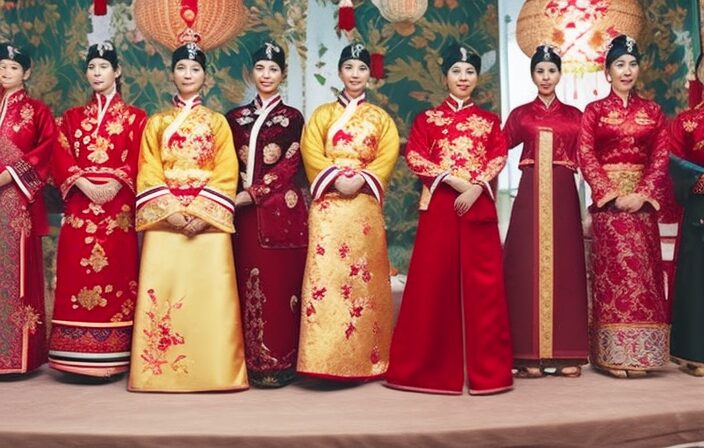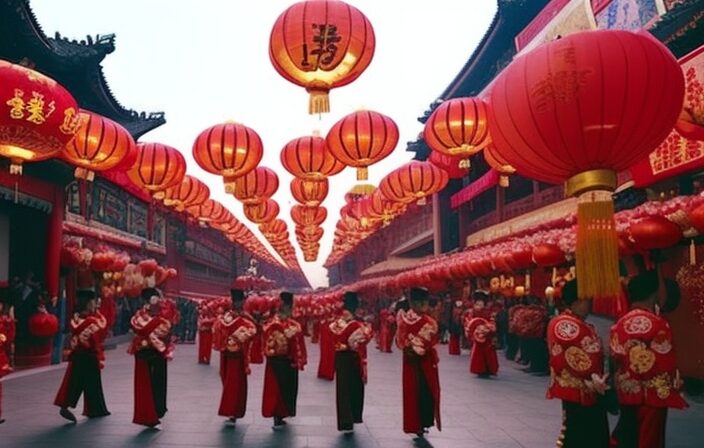Step into the world of Lunar New Year fashion, where tradition meets style and symbolism intertwines with modern interpretations.
Delve into the origins of this cultural phenomenon, exploring the rich history and significance behind the garments worn during this auspicious occasion.
From the intricate details of traditional Lunar New Year clothing to the evolving fashion trends that captivate the global stage, this article will unravel the hidden narratives and celebrate the timeless allure of Lunar New Year fashion.
Key Takeaways
- Lunar New Year fashion allows individuals to express their cultural identity and celebrate the new year with style and elegance.
- Red symbolizes good luck and happiness, while gold and yellow symbolize wealth and prosperity in Lunar New Year fashion.
- Traditional Lunar New Year garments vary across different countries, such as the cheongsam in China, the hanbok in South Korea, the ao dai in Vietnam, and traditional Chinese outfits in Malaysia.
- Contemporary Lunar New Year fashion incorporates innovative and modern elements, such as asymmetrical hemlines, off-the-shoulder necklines, jumpsuit styles, and modern silhouettes.
Origins of Lunar New Year Fashion
The origins of Lunar New Year fashion can be traced back to ancient Chinese traditions and customs. Lunar New Year, also known as Chinese New Year, is one of the most important festivals in Chinese culture. It is a time when families come together to celebrate the coming of a new year and to honor their ancestors. The clothing worn during this festival holds great cultural significance and is deeply rooted in traditional customs.
In ancient times, people believed that wearing new clothes during the Lunar New Year would bring good luck and prosperity for the year ahead. The colors and designs of the clothing were carefully chosen to symbolize various auspicious meanings. Red, for example, represents good luck and happiness, while gold and yellow symbolize wealth and prosperity.
Traditional customs also played a significant role in shaping Lunar New Year fashion. For example, the cheongsam, a form-fitting dress for women, became popular during the Qing Dynasty and is still commonly worn today. The intricate embroidery and vibrant colors of the cheongsam reflect the rich cultural heritage of China.
Overall, Lunar New Year fashion is a reflection of Chinese traditions and customs. It not only serves as a way to honor the past but also allows individuals to express their cultural identity and celebrate the start of a new year with style and elegance.
Symbolism in Traditional Lunar New Year Clothing
Symbolism plays a significant role in the attire worn during the celebration of the lunar new year. Traditional lunar new year clothing is rich in symbolism and cultural significance, reflecting the values and beliefs of the people who wear them.
Here are four key symbols commonly found in lunar new year attire:
-
Colors: Red is the dominant color in lunar new year clothing as it represents good luck, joy, and prosperity. Gold and yellow are also popular colors as they symbolize wealth and fortune.
-
Embroidery: Intricate embroidery is often seen on lunar new year clothing, showcasing traditional patterns and auspicious symbols. These embroidered motifs can include dragons, phoenixes, peonies, and other symbols associated with luck, happiness, and prosperity.
-
Animal motifs: The lunar zodiac animal for the year plays a significant role in lunar new year clothing. Each year is associated with a different animal, and people often wear clothing featuring the animal of the current year to bring good fortune and blessings.
-
Accessories: Traditional lunar new year clothing is often adorned with accessories such as jade jewelry, tassels, and silk scarves. Each accessory carries its own symbolism, such as jade representing wisdom and longevity, while tassels symbolize good luck and silk scarves symbolize wealth and prosperity.
These symbols in lunar new year attire not only add beauty and elegance but also serve to convey well wishes and blessings for the new year. They are a visual representation of the hopes and aspirations of the people celebrating the lunar new year, connecting them to their cultural heritage and traditions.
Evolution of Lunar New Year Fashion Trends
Over time, the way people dress during the celebration of the lunar new year has undergone significant changes, reflecting evolving fashion trends and cultural influences. The lunar new year is not only a time for family reunions and feasts but also an occasion for people to showcase their sartorial choices and pay homage to their cultural heritage.
Cultural influences play a pivotal role in shaping the fashion choices of individuals during the lunar new year celebrations. In recent years, there has been a shift towards a more modern and contemporary style, with younger generations incorporating elements of Western fashion into their traditional outfits. This fusion of traditional and modern elements has resulted in a unique blend of styles that reflects the changing tastes and preferences of the younger generation.
The impact of lunar new year fashion trends extends beyond individual wardrobe choices. The fashion industry has recognized the commercial potential of this festive period and has capitalized on it by creating collections and collaborations specifically targeted at lunar new year celebrations. Luxury brands, fashion designers, and retailers have all jumped on the bandwagon, producing limited edition lunar new year-themed clothing, accessories, and cosmetics.
This has not only generated substantial revenue for the fashion industry but has also helped to promote and preserve traditional cultural practices associated with the lunar new year.
Traditional Lunar New Year Garments Around the World
Garments worn during the celebration of the lunar new year vary across different cultures, showcasing the rich diversity and unique traditions associated with this festive occasion. From vibrant colors to intricate designs, traditional lunar new year clothing holds deep cultural significance and reflects regional variations.
Here are four examples:
-
China: The cheongsam, also known as qipao, is a form-fitting dress that originated in the 1920s Shanghai. It features a high collar, fitted waist, and slits on the sides. The cheongsam symbolizes elegance and femininity and is often worn in bright red, symbolizing good luck and prosperity.
-
South Korea: The hanbok is a traditional Korean garment worn during special occasions, including the lunar new year. It consists of a wrap-around jacket called jeogori and a skirt called chima. Hanboks are available in various colors and patterns, representing different social statuses and age groups.
-
Vietnam: The ao dai is the national costume of Vietnam, worn by both men and women. It is a long, flowing tunic worn over loose pants. The ao dai is often made from silk and features intricate embroidery. It represents elegance and grace.
-
Malaysia: In Malaysia, the lunar new year is celebrated by the Chinese community wearing traditional Chinese outfits, such as the cheongsam or the tangzhuang. These garments are often made from silk or brocade fabric and are adorned with auspicious symbols like dragons and phoenixes.
These examples highlight the regional variations and cultural significance of traditional lunar new year garments. They not only serve as a way to celebrate the festive occasion but also preserve and showcase the rich heritage and customs of each culture.
Modern Interpretations of Lunar New Year Fashion
Contemporary interpretations of lunar new year attire embody a fusion of cultural heritage and modern fashion trends, incorporating elements such as bold colors, innovative silhouettes, and intricate embellishments. In recent years, designers have been pushing the boundaries of traditional lunar new year fashion, creating modern and stylish garments that pay homage to cultural influences while appealing to the tastes of the younger generation.
Contemporary designs for lunar new year fashion often feature vibrant and eye-catching colors, such as red, gold, and purple, which symbolize luck, prosperity, and happiness in many Asian cultures. These colors are used not only in the fabric itself but also in the intricate embellishments and embroidery that adorn the garments. Embellishments such as sequins, beads, and crystals are used to create a sense of opulence and luxury, while still maintaining a sense of cultural authenticity.
In terms of silhouettes, designers have been incorporating innovative and modern elements into lunar new year attire. Traditional garments like the cheongsam or qipao have been reimagined with contemporary cuts and designs, featuring asymmetrical hemlines, off-the-shoulder necklines, and even jumpsuit styles. These modern silhouettes not only allow for more movement and comfort but also reflect the changing fashion preferences of the younger generation.
Overall, contemporary interpretations of lunar new year fashion strike a delicate balance between honoring cultural traditions and embracing modern trends. By incorporating bold colors, innovative silhouettes, and intricate embellishments, designers have successfully created garments that are both culturally meaningful and fashion-forward, appealing to a wide range of audiences. These modern interpretations of lunar new year attire serve as a testament to the evolving nature of fashion and its ability to reflect and celebrate cultural heritage.
What Are Some Lunar Calendar Traditions Associated with Lunar New Year?
During Lunar New Year, preserving lunar calendar traditions is essential. Families come together to celebrate with various customs and rituals. These may include cleaning the house to sweep away bad luck, decorating with red lanterns and scrolls, and sharing meals featuring symbolic dishes. Fireworks and dragon dances are also popular cultural practices that add to the festive atmosphere.
Conclusion
In conclusion, traditional Lunar New Year clothing and fashion have deep cultural roots and significant symbolism.
Over time, these garments have evolved to reflect changing trends and influences from different cultures.
From the iconic qipao in China to the hanbok in Korea, traditional Lunar New Year garments showcase the unique heritage of various countries.
Today, modern interpretations of Lunar New Year fashion blend traditional elements with contemporary styles, creating a fusion of cultural identity and fashion expression.
Like a vibrant tapestry, Lunar New Year fashion weaves together history, symbolism, and creativity.



